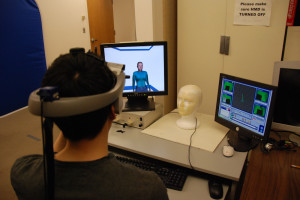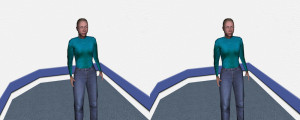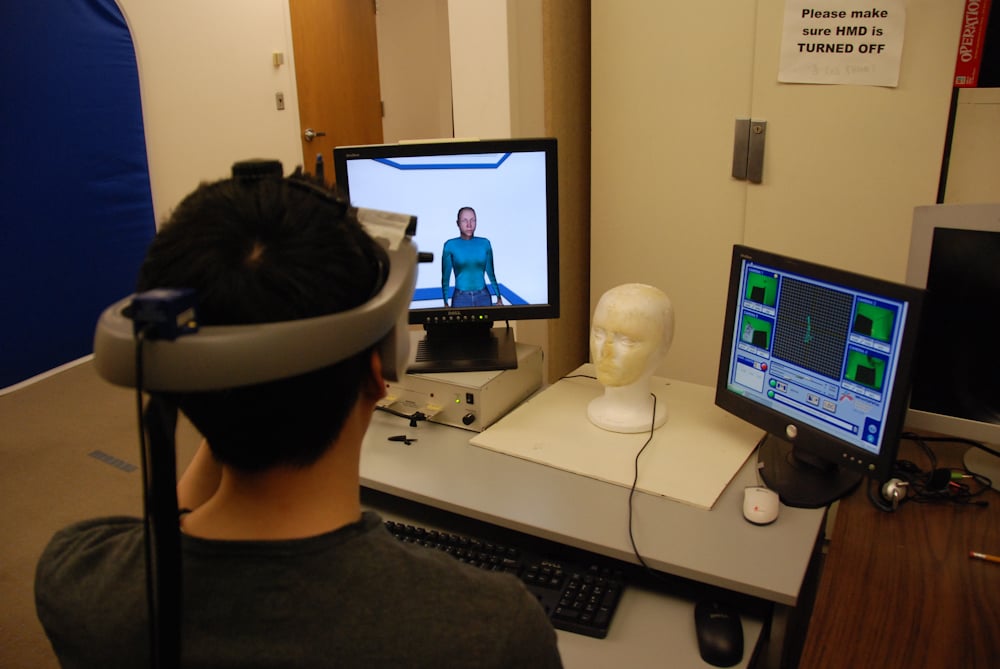It’s difficult to walk when you can’t see your feet, but misstep and you will still fall.
Authentic as the stomach-eliminating weightless feeling was, the lack of impact at the bottom reminded me that I was standing firmly on carpeted floor. It was more disorienting to look “up” at the lab manager speaking to me and to see no one.

I was participating in a virtual-reality demo called the “pit world” at Stanford’s Virtual Human Interaction Lab on the fourth floor of McClatchy Hall in the Main Quad. Recently renovated, the lab is full of cutting-edge Virtual Reality (VR) technology, including an elevated haptic floor and an ambisonic sound oralizer to create touch and sound feedback in virtual worlds.
Lab researchers study how everyday interactions are carried over into the virtual world and how virtual experiences can change physical behavior.
“We try to stay three to four years ahead of what other [researchers] are doing,” said Jeremy Bailenson, director of the lab and an associate professor of communication.
Bailenson developed the lab from a four-person project in 2003 and nurtured it into the sophisticated facility it is today.
Virtual Human Interaction Lab researchers collaborate on interdisciplinary projects with various departments at Stanford and other universities, as well as with tech companies. Current research topics include environmental conservation behavior, gesturing in teaching and social identity in virtual networks.
As part of my tour of the lab, I experienced a conservation behavior demonstration firsthand. When I put on the head-mounted display — a hefty piece of headgear with goggles — I was transported into a woodland scene and grasped a chainsaw firmly with large, manly arms that appeared to come out of my sides. Donning the avatar of a lumberjack for 30 seconds, I cut down a tree and watched it fall.
Subjects of the actual experiment were told that using recycled toilet paper could save the tree. After it fell, the forest sounds died out.
“It’s what we call pro-social behavior encouragement,” said Cody Karutz, the lab manager. Speeding up time in VR allows the participant to virtually compress his or her impact on the environment over 30 or 40 years into a couple of minutes.
“Right now, the idea of climate change is very abstract, and VR can put you in places that you never could be to make these connections more visceral,” Bailenson said.
In order to run the lab, Bailenson and his team employ 15 undergraduate programmers recruited through a summer training program. Programming each virtual world takes 200 to 300 hours.
“We have a lot of really fantastic equipment,” said undergraduate programmer Tina Roh ’14.
“We’re trying to figure out how we can use all that technology together,” said Pamela Martinez ’13. “It’s really exciting to work with a new technology in a way that no one has ever done before.”
Martinez was part of a team that hacked the Microsoft Kinect system to use it as an alternative to the lab’s tracking devices. Virtual reality involves tracking motions and rendering feedback, and with the Kinect emerging as the fastest-selling gadget in consumer history, millions of homes now have half of what they need for VR. In fact, Microsoft representatives visited the lab recently to study its use of the Kinect.
Karutz said he believes it is only a matter of time before the VR technology the lab uses becomes sophisticated enough to make distinguishing between real and virtual spaces difficult.
Entering the lab, one first sees a lenticular display on the opposite wall that renders 3D images without requiring the viewer to wear glasses. With increased development of haptic, or tactile, feedback, touch will no longer serve as a test of reality. Technically, the viewer could become immersed in a VR scene without being sure if the world is real or virtual.

This may raise ethical questions, especially in terms of advertising and marketing research, in addition to the manipulation of participant behavior in the sustainability experiment. The lab asserts, however, that all of its experiments are run through the Institutional Review Board and have zero ethical concerns.
“Our job as a lab is to think about how technology is changing and stay ahead of that,” Bailenson said. “We want to understand the ethics of people spending time in virtual spaces.”
